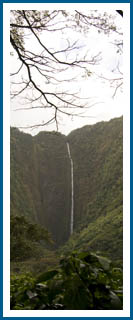Field Updates: January 2008 Scientist Account (by Heather Eijzenga)
Link to trip photo gallery
I had heard great things about the Waipi’o Stream Restoration Project, but this was the first time I had been able to participate. We arrived on Sunday to stock up on all the food and gear we would need over the next three days and then set out for Waipi’o. Byron was gracious enough to let us use his house as a base camp since the Araki Hotel is no longer an option. It was rainy and actually quite cold. The waterfalls in the valley were impressively full and David was reminded of the flood a few years back that trapped him and the other researchers in the valley. Once we tested all our gear and ate a light dinner, we attempted to sleep with the deafening roar of coqui frogs.
The next morning we were excited to meet with the group from Kanu o ka ‘aina charter school. They walked the long road from the top of the valley, but were still full of energy and ready to hit the streams. We grabbed our lunches and set off for Hi’ilawe Stream. During the stream protocol one of the feral horses in the valley became curious and came over to investigate. He walked to within inches of the girls and breathed in their face a few times before wandering off.
At the stream we divided into 3 groups and went over safety protocols, a serious concern since it was still raining and a flash flood is always a possibility. I was immediately impressed with the school group. Some of the kids had been involved with the project for several years and they quickly took charge, showing the new kids the proper methods and making sure everyone stayed on task. They had fun, but they were also very professional about it. We noticed the stream slowly rising while we worked and decided to call it a day just in case. Back at camp we enjoyed a group dinner and tried to stay warm.
Our plans for the day were cancelled by the unrelenting rain. We were supposed to head up to Lalakea Stream for more monitoring, but the swollen stream was moving too quickly for us to safely work in it. We decided to focus our efforts on arthropod collection instead. After instructing them on collecting techniques and supplying them with gear, they set off. They may have been a bit apprehensive at first, trying to catch insects without actually touching them, but that quickly off. With great gusto they swung nets, searched under rocks and leaves and generally scoured the area trying to collect as many species as possible. They weren’t quite as excited about filling a label for each collection, but that’s the important part. The highlights were native damselflies and dragonflies. At the end of the day we went through the collections and released any duplicates. The rest we took back to the museum for the group to identify using keys when they visited in March. In the evening we worked with some students on their science fair projects. They had been selected to go to the State Science Fair and were looking for tips on improving their presentation. It was an unexpected, but fun day.
Our final day and it was still raining. We had planned to meet with John from the Division of Aquatic Resources to help with an ongoing study at the muliwai, but he had an unexpected emergency and couldn’t make it. There was still too much rain to visit Lalakea Stream, so we decided to continue our arthropod survey in a different habitat, along the beach and stream. The high winds and rain made our task a bit difficult and we found much less than on the previous day. Some of the boys were collecting centipedes that were too large to even fit in our sample containers. Finally it was time for us to catch our flight back to Honolulu. Although we were looking forward to warm showers, we were sad to leave. This was really the greatest group of kids i’ve had the pleasure of working with. I’m sure that they taught me more than I taught them.
|


